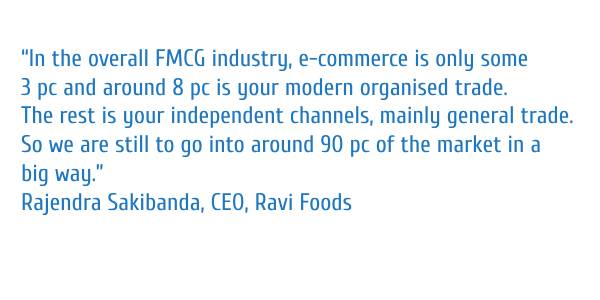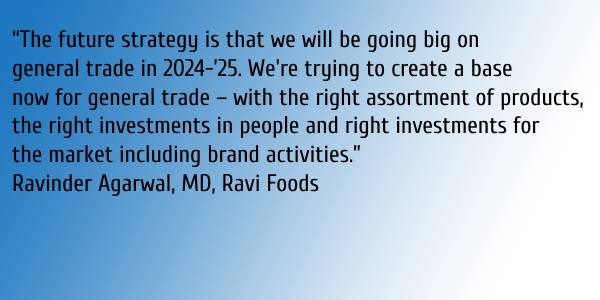Ravinder Agarwal was three when his father passed away in 1967. His brothers, the eldest of whom was 16, took charge of their father’s provision shop. Coming from a humble background, the large family from Rajasthan went into several businesses enduring several challenges, recalls Agarwal. Now, these Agarwals who have called Hyderabad home for over 100 years, are known nationally and globally for their brand of cream wafers and biscuits, Dukes.
“In 1984, we entered this industry with one of our cousins who was already into the biscuits business. It was called Rajco Foods. We progressed economically. The requirements of the family were met. Everything was slowly taken care of and the journey till now has been good. God has been kind. And it’s all because of the endless blessings of our father and mother. She is 93 and still around to bless us. My eldest brother is 73 years old and is very much active in the business. Another brother, Rameshji (71) is the architect of the family on the business side,” says Agarwal.
Ravi Foods was born in 1995 and Ravinder Agarwal was asked to run it. In its very first year, the company bagged an export order. It was like ‘reaching the moon’ says the company’s MD..
“I remember when we executed that transaction, when the manufacturing was happening, when the container was getting loaded and the first time we received money from exports… we were so thrilled. Since then, we have grown more and more in exports,” he adds.
The growth was slow to start with. Today the exports are twice the size of the domestic business.
“We are one of the largest exporters of biscuits from India today. 40 pc of our export now goes to the US, 40 pc to African countries and 20 pc to various other countries. We export to 138 countries. I don’t know how many are in the world,” quips Agarwal.
Private label and branded products contribute equally to exports, which rakes in close to Rs.1,000 cr, growing at 40 pc last year. Edited excerpts from an interview with Ravi Foods’ Agarwal and CEO Rajendra Sakibanda.
Ravi Foods was born from within the family business. Who set it up?
Ravinder Agarwal (RA): My brothers were handling other units and I was asked to look after Ravi Foods. My brothers have mentored us and help us even today. We are very proud to be together as a family.
Was Dukes Lemonade (owned by someone else) also around at that point? How did the name ‘Dukes’ come about?
RA: I was travelling with my elder brother Rameshji around Andhra Pradesh. It was a very rainy day and we were both sitting in the car. This was around 1993-’94 or maybe the beginning of 1995. We were about to name the brand. I started scribbling some names on the paper, even without knowing what I wanted to do or how to do it.
I wrote 45 names and showed it to my brother. He picked Dukes. I only knew that ‘Dukes’ meant something of high value that people look up to. The only thing I had heard was ‘Duke of Edinburgh’ from my school days. And I knew about the lemonade as well. We registered the name under our category.
How did the portfolio expand?
RA: We started with biscuits, launched cream wafers around 2000, confectionery in 2005, followed by chocolates in 2008.
Which is the biggest category for Dukes?
RA: Cream wafers. Technically, our product is called cream-filled wafers.
What is the geographic presence and how much does each product contribute?
RA: We have a pan-India presence. Dukes has a legacy of more than 25 years as a brand. The biggest advantage of this brand is its very high recall. It is synonymous with the cream wafers category. And today this category contributes about 45 pc within our domestic portfolio.
Confectioneries and chocolates – How big are those for Dukes?
RA: We have not played big on confectioneries and chocolates. Chocolates contribute 10 pc to the overall portfolio. Around 5 pc comes from confectionery.
We are focusing on the growing centre-filled candy category with Dukes Jigs. For this there is innovation required to fill the centre – the flavour has to be isolated from the overall shell and injected. It’s all done thanks to our R&D. There are a few more products which are already in the pipeline.
Tell us about the distribution channels and how much each contributes.
RA: Five years ago, we made a strategic shift to revamp the sales channels. We said rather than just being everywhere, we will give a strong value proposition to consumers. We wanted to be a household brand. To become this household brand, we first moved into modern trade. Today our cream wafer is number one in modern trade. We are present across Reliance, DMart, More Retail, other chains and regional modern trade.
RS: Out of our total turnover, 50 pc is from modern trade, 20 pc is from institutional sales, 20 pc from general trade and 10 pc from e-commerce.
RA: We aspire to be among the top five brands in the categories we are present in. We don’t aspire to have a market share of 30 or 40 pc. We are not taking that route because it is so cluttered. If we have to give a value proposition for consumers, we should not spend too much on logistics and operational costs. We said let us pass that cost benefit onto the consumer
We strategically focused on modern trade. More than market share, we believe in ‘Share Among Handlers’ (SH or counter share). Our SH at Reliance or DMart will be somewhere like 70 to 80 pc. If there are 100 pieces of cream wafers sold in a modern retail outlet, 70 of them will be Dukes Waffy.
Secondly, we have been very confident on the price points, like the magic price points of Rs.10 and Rs.20.
Coming to e-commerce. You have two major players in Flipkart and Amazon. Apart from that you have quick commerce players. We are there now across quick commerce and we are among the top five brands.
In e-commerce and in particular quick commerce, which is impulse-led, no one can influence the channels. It’s purely demand-led. We have been targeting the millennials through digital campaigns, investing more on digital. That has helped get traction. But unless your product ratings are above four on a scale of five,the product doesn’t get traction. And this cannot be created. It is purely an open platform where the consumer is the deciding factor.
Also, the biggest trend today across modern trade and e-commerce is super saver packs.
You say you are among the top five brands on e-commerce. Does that include products other than cream wafer brand Waffy?
RS: It’s across – Bourbon, Nice, Digestive… The category of biscuit is segmented. There is cream, cookies, plain biscuits and so on. Cream wafers is also a kind of biscuit.
Cookies is the largest (across industry) at around 29 pc followed by cream at 18 pc. So if anyone has to really win the market, they have to be strong in these two categories. But that comes with a lot of operational cost. And it is a highly cluttered segment currently.
What we did is we picked Bourbon from creams and we played big. Now, in modern trade we are also number one in Bourbon. Dukes Bourbon’s counter share will be almost 60 pc. That’s because we have given a value proposition to the consumers. The per-kilo pricing, the recipe and product quality which we offer to a consumer, nothing compares with it.
What is the price difference between Dukes Bourbon and others?
RS: Dukes Bourbon is priced at Rs.18 for 135 grams. ITC’s is at Rs,20 for 120 grams. Britannia’s is higher than that, I think Rs,25 for 120 grams.

The general trade (GT) is a large category that you say you have been selective on. Is that an opportunity?
RS: In the overall FMCG industry, e-commerce is only some 3 pc and around 8 pc is your modern organised trade. The rest is your independent channels, mainly general trade. So we are still to go into around 90 pc of the market in a big way.
RA: We have been very selective on general trade. The future strategy is that we will be going big on general trade in 2024-’25. We’re trying to create a base now for general trade – with the right assortment of products, the right investments in people and right investments for the market including brand activities.
 When you say the right assortment, do you mean launching new products within these categories?
When you say the right assortment, do you mean launching new products within these categories?
RA: We have to benchmark ourselves because it is a highly cluttered market in the categories we are in, especially confectionery and biscuits. The branded products account for 60 to 70 pc of the market and that means there is a large non-branded market available. We have to ensure we go with the right assortment to give a better experience to consumers. We also want to ensure aspects like freshness – we want to ensure that the product is not on the shelf beyond a month or two.
The product and the price point we want to play in becomes very critical. Largely, it will be the Rs.10 price point and within cookies, we’ll pick butter. We are also going to refresh the existing SKUs. After more than five years, our Bourbon will see a new and fresh packaging.
RS: Secondly, we’ll be doing brand extension as a strategy. We want to increase the market size for cream wafers with a new extension, Dukes Duetz Waffy. We’ll be the first mover on this innovation within cream wafers. Within the wafer, there will be two different flavours, two creams. One of them will be chocolate and the other orange. Another variant has orange with strawberry. We have already piloted this in a few modern trade stores and we’ll be playing big from January 2024. The response is good and the product is good to kick off pan India.
In Bourbon, there’s no one offering a coffee flavour. So far it is only chocolate. We’ll be launching that on very select platforms.
We are piloting cakes and it is doing extremely well.
The strategy is very clear. The competitive advantage will either be through comparative advantage or differential advantage. The comparative advantage is a price game. To leverage differential advantage, we’re going to introduce some premium products and take a premium pricing also.
There’s a new category which is evolving, which is within non-salt crackers. We have launched Dukes Cream Square, which is like a sandwich cream cracker. We are creating and growing some new categories.
We have introduced a product which we have very consciously launched in general trade and only in DMart – Dukes Italian Crisps. These are crunchy thin biscuits. I can tell you it is irresistible in taste. We have adopted a bridge pricing strategy and are offering a one-plus-one at launch to get people to try it.
RA: We export this kind of product to the US and Europe. Because we have the advantage of our own production and we are exporters, we know what is the next thing happening globally. That is the biggest advantage we carry.
Within the larger group, we have the experience and the infrastructure of manufacturing not just for exports but even for other companies, like ITC, Parle and Britannia.
So once you get into general trade, will you need to go a little aggressive on marketing?
RA: We already allocate 12 to 15 pc of our revenue for marketing and R&D (combined). Both modern trade and e-commerce require substantial marketing spends to ensure visibility. The brand is not new. With the Duke’s brand, we’ll get immediate penetration in general trade. But today the way distribution has evolved, the cost module is high compared to the past.
We need not talk about the brand, which is well accepted; it’s more of making it available. It is available today, but in a very selective way because we are slowly expanding. It has to be productive also – I have to give a better experience to the consumer and better profitability to my channel partners.
Even within general trade, we largely have plans of limiting ourselves to 50k population towns and above.
Will you be able to give the same kind of value proposition after building in the distribution and the sales network costs?
RS: We will definitely be able to. That’s why the assortment is very critical for us. We will definitely ensure that we are competitive.
MN4U SYNDICATE
(First published by The Free Press Journal BrandSutra. Content powered by MediaNews4u.com. Feedback: fpjbrandsutra@gmail.

















